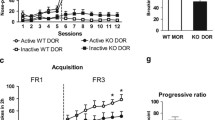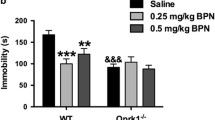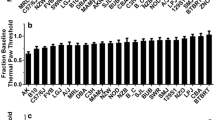Abstract
It is commonly thought thatμ-receptors play an important role in the reinforcing effects of opioids. In the present study, inbred strains widely divergent in CNS opiate receptor densities were used to investigate the influence of genetic variation in receptor concentration on opioid-reinforced behavior. In particular, the CXBK/ByJ mice were used as an investigative tool because of their significantly lower number of CNSμ opioid receptors. The behavioral pharmacology of opioids in theμ-deficient CXBK/ByJ mice was compared to other commonly used inbred mouse strains, C57BL/6J and BALB/cJ, and the opiate receptor rich CXBH/ByJ mice. Operant opioid reinforced behavior, opioid-induced locomotor stimulation, analgesia and respiratory depression were investigated in all four inbred strains. To assess the acquisition and maintenance of opioid reinforced behavior, oral self-administration of the potent benzimidazole opioid, etonitazene, was determined using an operant fixed-ratio schedule of reinforcement (FR 8). Acquisition of etonitazene-reinforced behavior was established in all four strains including theμ-deficient CXBK/ByJ mice. However, there were significant genetic differences in the amount of drug intake during the maintenance of opioid-reinforced behavior and extinction behavior following vehicle substitution. For example, drug intake was significantly greater in the BK versus BH mice during the maintenance phase and an extinction burst was seen in the BH but not the BK mice following vehicle substitution. Thus,μ-receptor density may not account for individual variability in the acquisition of opioid-reinforced behavior under these conditions. Sensitivity to etonitazene-induced respiratory depression, stimulation of locomotor activity and analgesia were unrelated to drug intake during self-administration sessions across these four inbred strains. These data indicate that inherited differences in CNSμ-opiate receptor concentrations do not affect acquisition of etonitazene-reinforced behavior.
Similar content being viewed by others
References
Bals-Kubic R, Shippenberg TS, Herz A (1990) Involvement of centralμ andδ opioid receptors in mediating the reinforcing effects ofβ-endorphin in the rat. Eur J Pharmacol 175:63–69
Baran A, Shuster L, Eleftheriou BE, Bailey DW (1975) Opiate receptors in mice: genetic differences. Life Sci 17:633–640
Beardsley PM, Meisch RA (1981) A precision drinking device for rats tested with water, etonitazene, and ethanol. Pharmacol Biochem Behav 14:871–876
Belknap JK, O'Toole LA (1992) Studies of genetic differences in response to opioid drugs. In: Harris RA and Crabbe JC (eds) The genetic basis of alcohol and drug actions. Plenum Press, New York, pp 225–252
Belknap JK, Noordewier B, Lame M (1989) Genetic dissociation of multiple morphine effects among C57BL/6J, DBA/2J and C3H/HeJ inbred mouse. Physiol Behav 46:69–74
Belknap JK, Lame M, Danielson PW (1990) Inbred strain differences in morphine-induced analgesia with the hot plate assay: a reassesment. Behav Genet 20:333–338
Belknap JK, Laursen SE, Sampson KE, Wilkie A (1991) Where are theμ receptors that mediate opioid analgesia? An autoradiographic study in the HAR and LAR selection lines. J Addict Dis 10:29–44
Bertalmio A, Woods JH (1989) Reinforcing effect of alfentanil is mediated byμ opioid receptors: apparent pA2 analysis. J Pharmacol Exp Ther 251:455–460
Carroll ME, Meisch RA (1978) Etonitazene as a reinforcer: Oral intake of etonitazene by rhesus monkeys. Psychopharmacology 59:225–229
Carroll ME, France CP, Meisch RA (1981) Intravenous self-administration of etonitazene, cocaine and phencyclidine in rats during food deprivation and satiation. J Pharmacol. Exp Ther 214:339–346
Crabbe JC, Phillips TJ, Kosobud A, Belknap JK (1990) Estimation of genetic correlation: Interpretation of experiments using selectively bred and inbred animals. Alcohol Clin Exp Res 14:141–151
Cunningham CL, Niehus DR, Malott DH, Prather LK (1992) Genetic differences in the rewarding and activating effects of morphine and ethanol. Psychopharmacology 107:385–393
Devor EJ, Reich T, Cloninger CR (1988) Genetics of alcoholism and related end-organ damage. Semin Liver Dis 8:1–11
Elmer GI, Meisch RA, George FR (1987a) Mouse strain differences in operant self-administration of ethanol. Behav Genet 17:439–451
Elmer GI, Meisch RA, George FR (1987b) Differential concentration-response curves for oral ethanol self-administration in C57BL/6J and BALB/cJ mice. Alcohol 4:63–68
Elmer GI, Meisch RA, Goldberg SR, George FR (1988) A fixed ratio analysis of oral ethanol reinforced behavior in inbred mouse strains. Psychopharmacology 96:431–436
Elmer GI, Meisch RA, Goldberg SR, George FR (1990) Ethanol self-administration in Long Sleep and Short Sleep mice: evidence for genetic independence of neurosensitivity and reinforcement. J Pharmacol Exp Ther 254:1054–1062
Elmer GI, Mathura CB, Goldberg SR (1993) Genetic factors in conditioned tolerance to the analgesic effects of etonitazene. Pharmacol Biochem Behav 45:251–254
Ferster CB, Skinner BF (1957) Schedules of reinforcement. Appleton-Century-Crofts, New York
Franklin KBJ, Abbot FV (1989) Techniques for assessing the effects of drugs on nociceptive responses. In: Boulton AA, Baker GB, Greenshaw AJ (eds) Neuromethods. Humana Press, Clifton, New Jersey, pp 145–216
Funada M, Narita M, Hayashi Y, Suzuki T, Misawa M, Nagase H (1991) Reinforcing property of morphine in the CXBK mouse: characteristics ofμ opioid receptor subtypes. In: Van Ree JM, Mulder AH, Wiegant VM, Van Wimersma-Greidanus TB (eds) New leads in opioid research, pp 130–131
George FR, Elmer GI, Meisch RA, Goldberg SR (1991) Orally delivered cocaine functions as a positive reinforcer in C57BL/6J mice. Pharmacol Biochem Behav 38:897–903
George FR, Goldberg SR (1989) Genetic approaches to the analysis of addiction processes. Trends Pharmacol Sci 10:73–83
George FR, Ritz MR, Elmer GI (1991) The role of genetics in drug dependence. In: Pratt J (ed) The biological basis of drug tolerance and dependence. Academic Press, New York, pp 265–290
Goldberg SR, Gardner ML (1981) Second-order schedules: extended sequences of behavior controlled by brief environmental stimuli associated with drug self-administration. In: Thompson T, Johanson CE (eds) NIDA Research Monograph 37. US Govt Printing Office, Washington, D.C., pp 241–270
Grant KA, Johanson CE (1987) Diazepam self-administration and resistance to extinction. Pharmacol Biochem Behav 28:81–86
Horowitz GP, Whitney G, Smith JC, Stephan FK (1977) Morphine ingestion: genetic control in mice. Psychopharmacology 52:119–122
Howerton TC, O'Connor ME, Collins AC (1983) Lipid solubility is correlated with hypnotic and hypothermic responses of Long-Sleep (LS) and Short-Sleep (SS) mice to various depressant drugs. J Pharmacol Exp Ther 227:389–393
Hyytiaa P, Sinclair JD (1993) Oral etonitazene and cocaine consumption by AA, ANA and Wistar rats. Psychopharmacology 111:409–414
Jacob J, Michaud G, Nicola M-A, Prudhomme N (1983) Genetic differences in opioid binding and in antinociceptive activities of morphine and ethylketocyclazocine. Life Sci 33:645–648
Jiang Q, Mosberg HI, Porreca F (1990) Modulation of the potency and efficacy of mu-mediated antinociception by delta agonists in the mouse. J Pharmacol Exp Ther 254:683–689
Ling GSF, Spiegel K, Lockhart SH, Pasternak GW (1985) Separation of opioid analgesia from respiratory depression: evidence for different receptor mechanisms. J Pharmacol Exp Ther 232:149–155
Mackintosh NJ (1974) The psychology of animal learning. Academic Press, New York
Marek P, Yirmiya R, Liebeskind JC (1988) Strain differences in the magnitude of swimming-induced analgesia in mice correlate with brain opiate receptor concentration. Brain Res 447:188–190
Marek P, Yirmiya R, Liebeskind JC (1990) Genetic influences on brain stimulation-produced analgesia in mice: II. Correlation with brain opiate receptor concentration. Brain Res 507:155–157
Meisch RA (1975) The function of schedule-induced polydipsia in establishing ethanol as a positive reinforcer. Pharmacol Rev 27:465–473
Miczek KA, Thompson ML, Shuster L (1982) Opioid-like analgesia in defeated mice. Science 215:1520–1522
Miner LL, Marks MJ, Collins AC (1986) Genetic analysis of nicotine-induced seizures and hippocampal nicotinic receptors in the mouse. J Pharmacol Exp Ther 239:853–860
Moskowitz AS, Goodman RR (1985) Autoradiographic analysis ofμ 1,μ 2, and delta opioid binding in the central nervous system of C57BL/By and CXBK (opioid receptor-deficient) mice. Brain Res 360:108–116
Moskowitz AS, Terman GW, Carter KR, Morgan JM, Liebeskind JC (1985) Analgesic, locomotor and lethal effects of morphine in the mouse: strain comparisons. Brain Res 361:46–51
Muraki T, Kato R (1986) Strain differences in the effects of morphine on the rectal temperature and respiratory rate in male mice. Psychopharmacology 89:60–64
Negus SS, Henriksen SJ, Mattox R, Pasternack GW, Portoghese PS, Takemori AE, Weinger MB, Koob GS (1993) Effects of antagonists selective forμ andδ on the reinforceing effects of heroin in the rat. J Pharmacol Exp Ther 265:1245–1252
Nichols JR, Hsiao S (1967) Addiction liability of albino rats: breeding for quantitative differences in morphine drinking. Science 157:561–563
Oliverio A, Castellano C (1974) Genotype-dependent sensitivity and tolerance to morphine and heroin: dissociation between opiate-induced running and analgesia in the mouse Psychopharmacologia 39:13–22
Oliverio A, Castellano C (1981) Behavioral effects of opiates: pharmacogenetic analysis. Curr Dev Psychopharmacol 6:45–64
Piazza PV, Deminiere J-M, Le Moal M, Simon H (1989) Factors that predict individual vulnerability to amphetamine self-administration. Science 245:1511–1513
Pick CG, Nejat RJ, Pasternak GW (1993) Independent expression of two pharmacologically distinct supraspinal mu analgesic systems in genetically different mouse strains. J Pharmacol Exp Ther 265:166–171
Raffa RB, Mathiasen JR, Jacoby HI (1987) Colonic bead expulsion time in normal andμ-opioid receptor deficient (CXBK) mice folloing central (ICV) administration ofμ- andδ-opioid agonists. Life Sci 41:2229–2234
Reith MEA, Sershen H, Vadasz C, Lajtha A (1981) Strain differences in opiate receptors in mouse brain. Eur J Pharmacol 74:377–380
Shippenburg TS, Bals-Kubik R, Herz A (1987) Motivational properties of opioids: evidence that an activation ofδ-receptors mediates reinforcement processes. Brain Res 436:234–239
Spuhler K, Hoffer B, Weiner N, Palmer MR (1983) Evidence for genetic correlation of hypnotic effects and cerebellar Purkinje neuron depression in response to ethanol in mice. Pharmacol Biochem Behav 17:1073–1076
Suzuki T, George FR, Meisch RA (1988) Differential establishment and maintenance of oral ethanol reinforced behavior in Lewis and Fischer 344 inbred rat strains. J Pharmacol Exp Ther 245:164–170
Suzuki T, George FR, Meisch RA (1992) Etonitazene delivered orally serves as a reinforcer for Lewis but not Fischer 344 rats. Pharmacol Biochem Behav 42:579–586
Taub DD, Eisentsein TK, Geller EB, Adler MW, Rogers TJ (1991) Immunomodulatory activity ofμ andκ-selective opioid agonists. Proc Natl Acad Sci 88:360–364
Tortella FC, Moreton JE (1980)D-Ala2-Methionine-enkephalinamide self-administration in the morphine-dependent rat. Psychopharmacology 69:143–147
Vaught JL, Mathiasen JR, Raffa RB (1988) Examination of the involvement of supraspinal and spinalμ andδ opioid receptors in analgesia using theμ receptor deficient CXBK mouse. J Pharmacol Exp Ther 245:13–16
Wise RA, Bozarth MA (1987) A psychomotor stimulant theory of addiction. Psychol Rev 94:469–492
Woods JH, Schuster CR (1971) Opiates as reinforcing stimuli. In: Thompson T, Pickens RW (eds) Stimulus properties of drugs. Appleton-Century-Crofts, New York, pp 163–175
Woods JH, Katz JL, Young AM, Medzihradsky F, Smith CB (1981) Correlations among certain behavioral, physiological, and biochemical effects of narcotic agonists. In: Harris LS (ed) Problems of drug dependence. DHHS Publication, Washington, D.C., pp 43–57
Young AM, Swain HH, Woods JH (1981) Comparison of opioid agonists in maintaining responding and in suppressing morphine withdrawal in rhesus monkeys. Psychopharmacology 74:329–335
Young AM, Woods JH, Herling S, Hein DW (1983) Comparison of the reinforcing and discriminative stimulus properties of opioids and opioid peptides. In: Smith JE, Lane JE (eds) The neurobiology of opiate reward processes, pp 147–174
Author information
Authors and Affiliations
Rights and permissions
About this article
Cite this article
Elmer, G.I., Pieper, J.O., Goldberg, S.R. et al. Opioid operant self-administration, analgesia, stimulation and respiratory depression inμ-deficient mice. Psychopharmacology 117, 23–31 (1995). https://doi.org/10.1007/BF02245094
Received:
Revised:
Issue Date:
DOI: https://doi.org/10.1007/BF02245094




